#minmi paravertebra
Text

hanging with my favourite dinosaur, ❤ MINMI ❤
Minmi paravertebra was small (2.5-3m long) and lived in Australia like me. Perhaps in another life we could have been friends. At least I can draw him having a fun eating apples
#paleoart#dinosaur#australian animals#minmi paravertebra#ankylosauria#art#illustration#elbarklaart#ankylosaurus
57 notes
·
View notes
Photo

Minmi Paravertebra, by Greer Strothers.
Minmi paravertebra is a basal ankylosaurid from Cretaceous Australia.
49 notes
·
View notes
Text
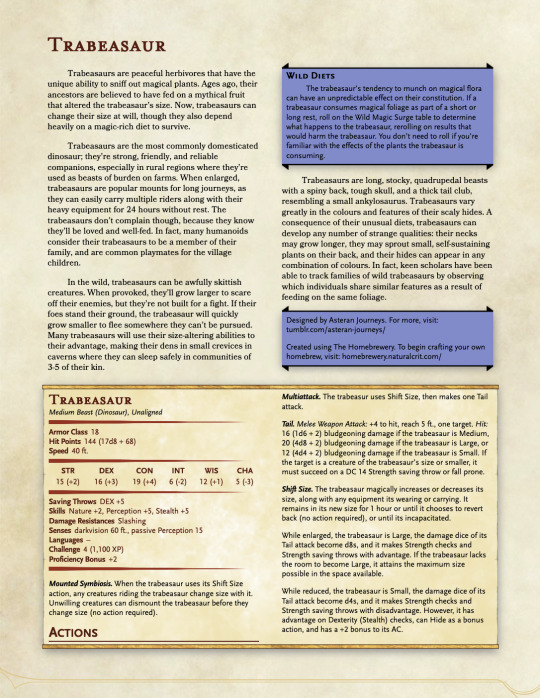
Here's my fifth dinosaur stat block guys. Only one more until the end of Dinosaur Month! 🦕
Trabeasaurs are gentle giants capable of altering their size to suit their needs. Just don't feed them any suspicious-looking plants.
The trabeasaur was inspired by the Minmi paravertebra, the first ankylosaur to be discovered in the Southern Hemisphere. You can learn more about them and other Australian dinosaurs from the Australian Museum here.
The concept of the trabeasaur came purely by its genus 'minmi'. As soon as I misread it as 'minim', I knew I wanted to make this a small dinosaur. To distinguish it from the typical ankylosaur, I gave the trabeasaur the ability to change its size. That way, it'd have some flexibility in how it approaches different situations. I also just like the mental image of a timid little dinosaur skittering away from something scary.
4 notes
·
View notes
Text
I was “Today” years old...
Just realized my favorite Toho era Kaiju, Anguirus, is my favorite dinosaur, Minmi paravertebra, cranked up to 11.

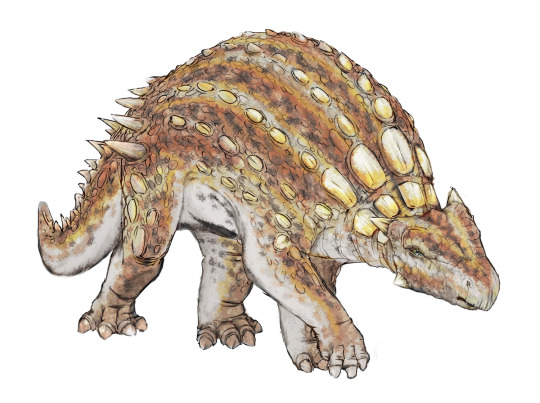
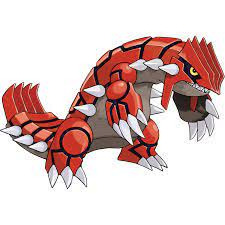
Also, I’ve been playing a lot of Pok’emon lately, so, have a groudon, and while mentioning Minmi...

#Michiko Evwana#Minimi Paravertebra#Minmi#Anguirus#Groudon#toho studios#kaiju#Dinosaur#Dragon#pokémon
2 notes
·
View notes
Text
Minmi paravertebra
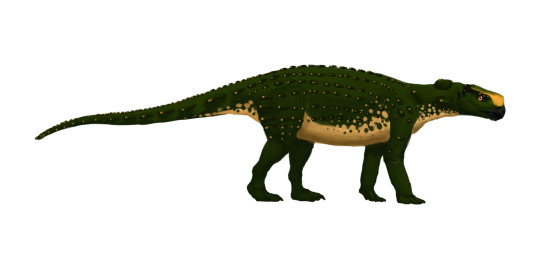
By Ashley Patch on @apatchsketches!
PLEASE support us on Patreon! We really do need all of your support to keep this blog running - any amount helps!
Name: Minmi paravertebra
Name Meaning: Named for Minmi Crossing
First Described: 1980
Described By: Molnar
Classification: Dinosauria, Ornithischia, Genasauria, Thyreophora, Eurypoda, Ankylosauria, Ankylosauridae
Minmi is a poorly known early derived Ankylosaur from the Aptian age of the Early Cretaceous, sometime between 119 and 113 million years ago. It was found in the Bungil Formation in Queensland, Australia, and is known from scattered portions of the skeleton, including some belly armour. Most of the decent material that was once ascribed to Minmi has since been given its own genus, Kunbarrasaurus, and its cladistic position is unclear, with current estimates having it as an early derived Ankylosaurid. Despite the poor remains, it is a distinct genus.
Sources:
https://en.wikipedia.org/wiki/Minmi_(dinosaur)
Arbour, V. M, & P. J. Currie. 2015. Systematics, phylogeny and palaeobiogeography of the ankylosaurid dinosaurs. Journal of Systematic Palaeontology DOI: 10.1080/14772019.2015.1059985
Shout out goes to @dinowcow6-9!
#minmi#minmi paravertebra#ankylosaur#ankylosaurid#dinosaur#dinowcow6-9#palaeoblr#paleontology#prehistory#prehistoric life#dinosaurs#biology#a dinosaur a day#a-dinosaur-a-day#dinosaur of the day#dinosaur-of-the-day#science#nature#factfile#Dìneasar#דינוזאור#डायनासोर#ديناصور#ডাইনোসর#risaeðla#ڈایناسور#deinosor#恐龍#恐龙#динозавр
61 notes
·
View notes
Text
Tuesday 5/10/21 - Dinosaurs of the World Part 1; Australia and Antarctica
Something dinosaur enjoyers might not appreciate right away is that our vast knowledge of this group of reptiles spans a worldwide communities of scientists. And sure palaeontology may have had its foundation in the western powers of Britain and America, but some of today's most popular dinosaurs come from other continents newer to Palaeontology. Particularly, South America, and East Asia have become hotspots for many of modern palaeontology's most exciting dinosaur discoveries. I've been wanting to do an overview series to highlight some of the more exciting (personal opinion) dinosaur species native to different regions of the world.
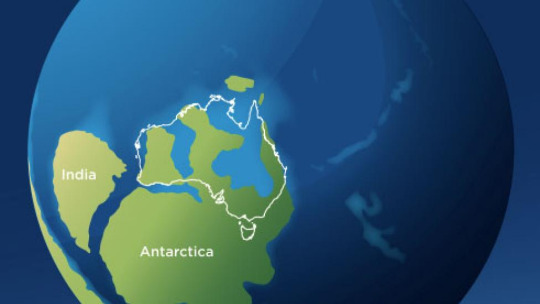
Late Cretaceous Australia
For Part 1, I'm going to feature Dinosaurs from Australia and Antarctica, since I'm from Australia. Palaeontology is a relatively smaller field in my country than it is in America for example, and so many of our dinosaur species are less well known throughout the world. The only major piece of Paleo-Media featuring Australian Dinosaurs from memory is Episode 5 of Walking With Dinosaurs, which focuses on the wintery land of late-Cretaceous Australia-Antarctica. For much of the Mesozoic period, Australia and Antarctica were connected to each other, but separated from most other continents, so this is why I am featuring them together.
Cryolophosaurus ellioti

Cryolophosaurus, Hannah Böving
Cryolophosaurus was the first dinosaur species to be named from Antarctica. Its remains were found in the Transantarctic Mountain Range in the early 1990s and named in 1994. Its name means "Cold Crested Reptile" referring to the large comb shaped crest on its skull, and that it was found in Antarctica. It was an earlier therapod (Early Jurassic), probably more primitive in the family tree than more well known therapods like Spinosaurus, Allosaurus, or Tyrannosaurus. It was one of the largest meat eaters of its time, about 2.5 m tall at the hip, and 6-7 m long. During the Early Jurassic, Antarctica was closer to the Equator, but it was still a relatively cooler climate, so some artists speculate it may have had a coat of feathers.
Minmi paravertebra
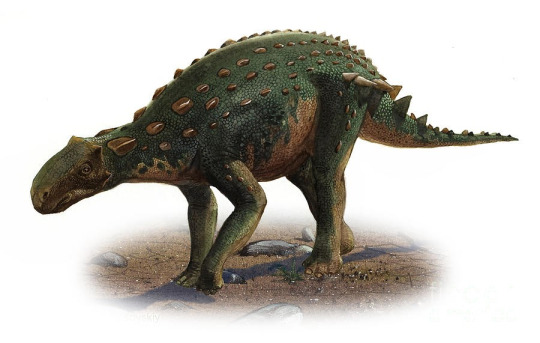
Minmi, Sergey Krasovskiy
Minmi was a basal ankylosaurid nodosaur found in Queensland Australia. It was named after the Minmi Crossing, and as a result of incorporating no other terminology into it's genus name, Minmi long held the record for the shortest genus name of any dinosaur. It was recently dethroned by Chinese dinosaur Yi. Minmi's fossils were quite fragmentary and much of our current guess of its appearance are based on its close relative Kunbarrasaurus. Minmi not only had a short name, it was also a very small dinosaur, about 3 m long and less than a metre tall. Imagine an ankylosaur about the size of a family dog. Minmi was Early Cretaceous in age.
Muttaburrasaurus langdoni
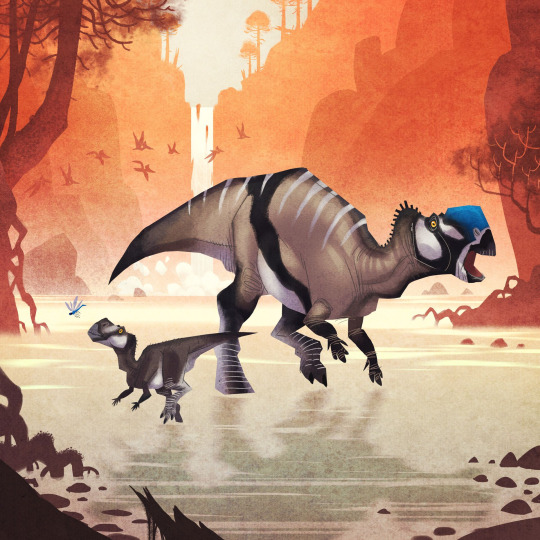
Muttaburrasaurus, Johan Egerkrans
Muttaburrasaurus is one of Australia's best known dinosaurs, partially due to how complete its best skeleton was. The only Australian specimen more complete is of Minmi's cousin Kunbarrasaurus. It was named for the town of Muttaburra, Queensland, which was near to its site of discovery. Muttaburrasaurus was an Ornithopod, a relative of Iguanodon. It was a fairly large herbivore, about 2.5 m tall at the shoulder and about 8 m long. It had a large hollow nose cavity that some palaeontologists think may have been used to make loud trumpeting calls like some of its hadrosaur distant relatives, but the evidence is inconclusive at this point.
Australotitan cooperensis
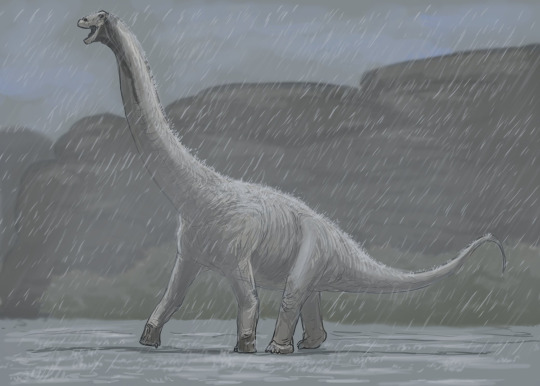
Australotitan, Joshua Knüppe
A very recent discovery, actually only just June 2021, Australotitan is the largest dinosaur discovered in the country so far, about 6.5 m at the hip, and 30 m long. It was a late Cretaceous Titanosaur, the group that includes the largest dinosaurs of all time such as Argentinosaurus and Dreadnoughtus. Its genus name means "Southern Titan", from the same greek word, Australis, that Australia got its name from. Its remains were found in Central Queensland, Australia. Before a species name was decided, it was referred to as "Cooper", for the Cooper Creek nearby its discovery. Its species name, cooperensis, later took on this naming reference.
Leaellynosaura amicagraphica

Leaellynosaura, sm-forrester (deviantart)
Leaellynosaura was a small Early Cretaceous basal Ornithopod, found from Victoria, Australia. At the time that Leaellynasaura was alive, Victoria was located within the Antarctic circle, so it was a polar dinosaur. Although the Cretaceous climate would've been warmer in the south pole than it is today, Leaellynasaura would've still experienced several months a year without full sunlight, and skull fragments have suggested it may have had eyes evolved for low-light vision. It was named after the daughter of the two palaeontologists who discovered the fossil, Leaellyn Rich. The most peculiar part of this dinosaur was its ridiculously long tail, which has been reconstructed as 3 times longer than the rest of its body combined.
Australovenator wintonensis
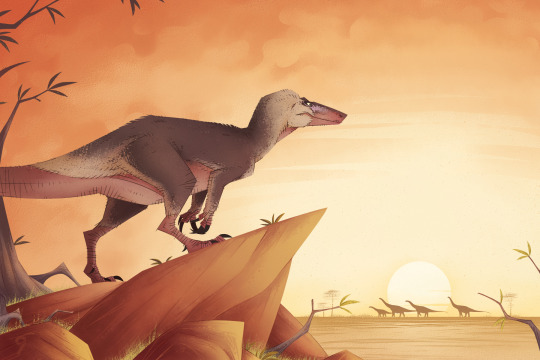
Australovenator, @just9art (twitter and tumblr)
Australovenator was a Late Cretaceous apex predator therapod. Its bones compile the most complete predatory dinosaur remains in Australia. At 2 m tall at the hip and 6 m in length, it was a lightly built therapod, and was likely an active pursuit predator. Its name means "Southern Hunter". It was discovered in Central Queensland, Australia. Its best preserved bones were of its arms and legs, and study of these have led Australovenator to be classified as a Megaraptoran therapod, cousin to Allosaurus and Carcharodontosaurus, but more remains need to be found in order to be sure.
Thanks for Reading
If you enjoyed this read and learned about something new, please spread it around. This is only Part 1 in the series, and I will edit this to link to future parts when they're written. I'm thinking of writing about Asia next, since a lot of exciting discoveries have been made recently in that region. If you know any Asian dinosaurs you think really deserve a highlight, let us know. If you know any fun facts on other Australia-Antarctica dinosaurs, feel free to share them in the notes.
A lot of this article is based on my own general knowledge, but I did borrow some information from Wikipedia. Feel free to correct me on whatever in the notes.
|| Part 2 (Asia) >>
#blog#blogpost#dinosaurs#palaeontology#australian dinosaurs#antartica dinosaurs#cryolophosaurus#minmi#muttaburrasaurus#australotitan#leaellynasaura#australovenator
63 notes
·
View notes
Photo
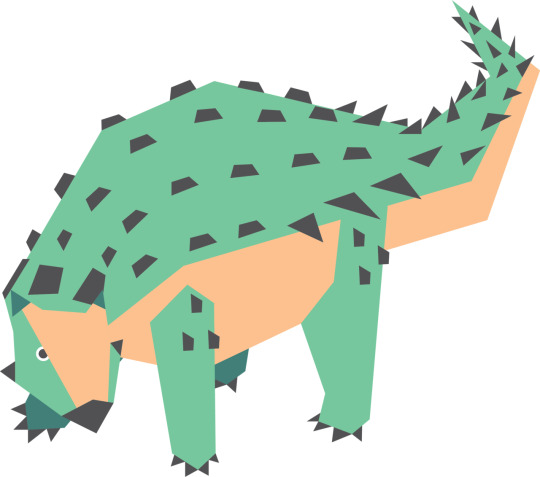

Minmi (which I just found out to be a Japanese Singer as well), is known as the dinosaur with the shortest forename. Its full name is Minmi paravertebral. It was an Ankylosaurian that had horizontally orientated plates along the sides of its vertebrae.
This dinosaur is also known for being an Australian dinosaur as it was discovered north of Roma in 1964 by Dr Alan Bartholomal.
The first image is by @dianeramic
The second image source: https://australianmuseum.net.au/…/fact-…/minmi-paravertebra/
#minmi#australia#ankylosaur#extinct animals#extinct animal of the day#extinct animal#japanese singer#minmi dinosaur
1 note
·
View note